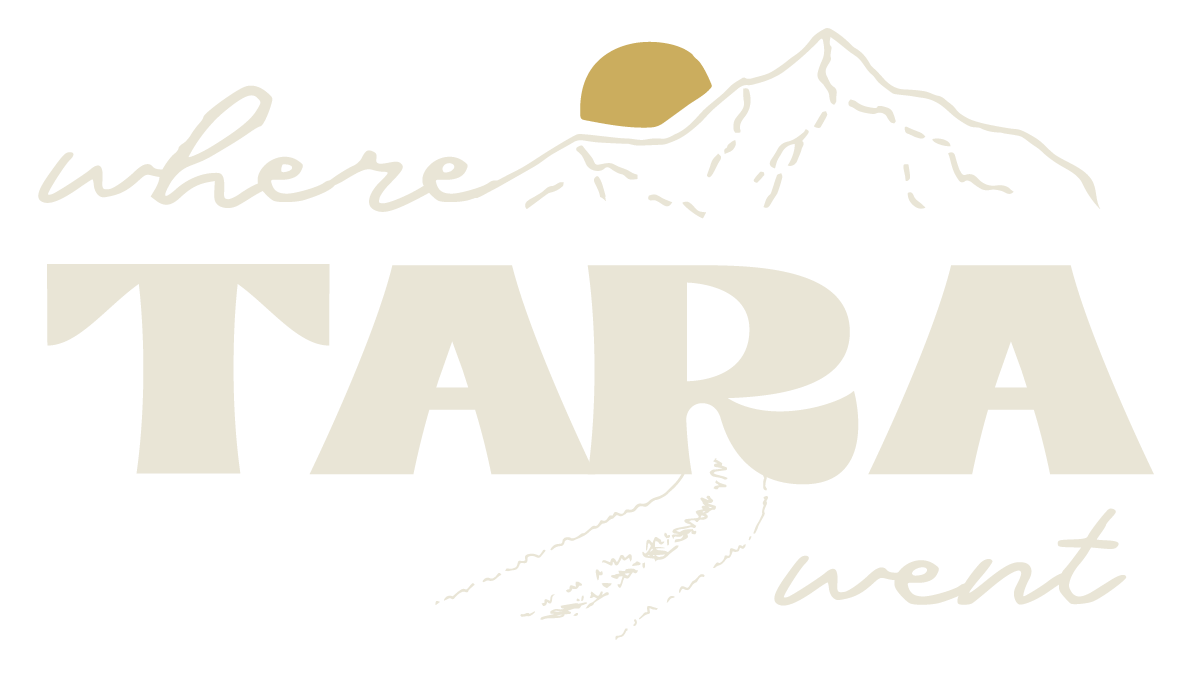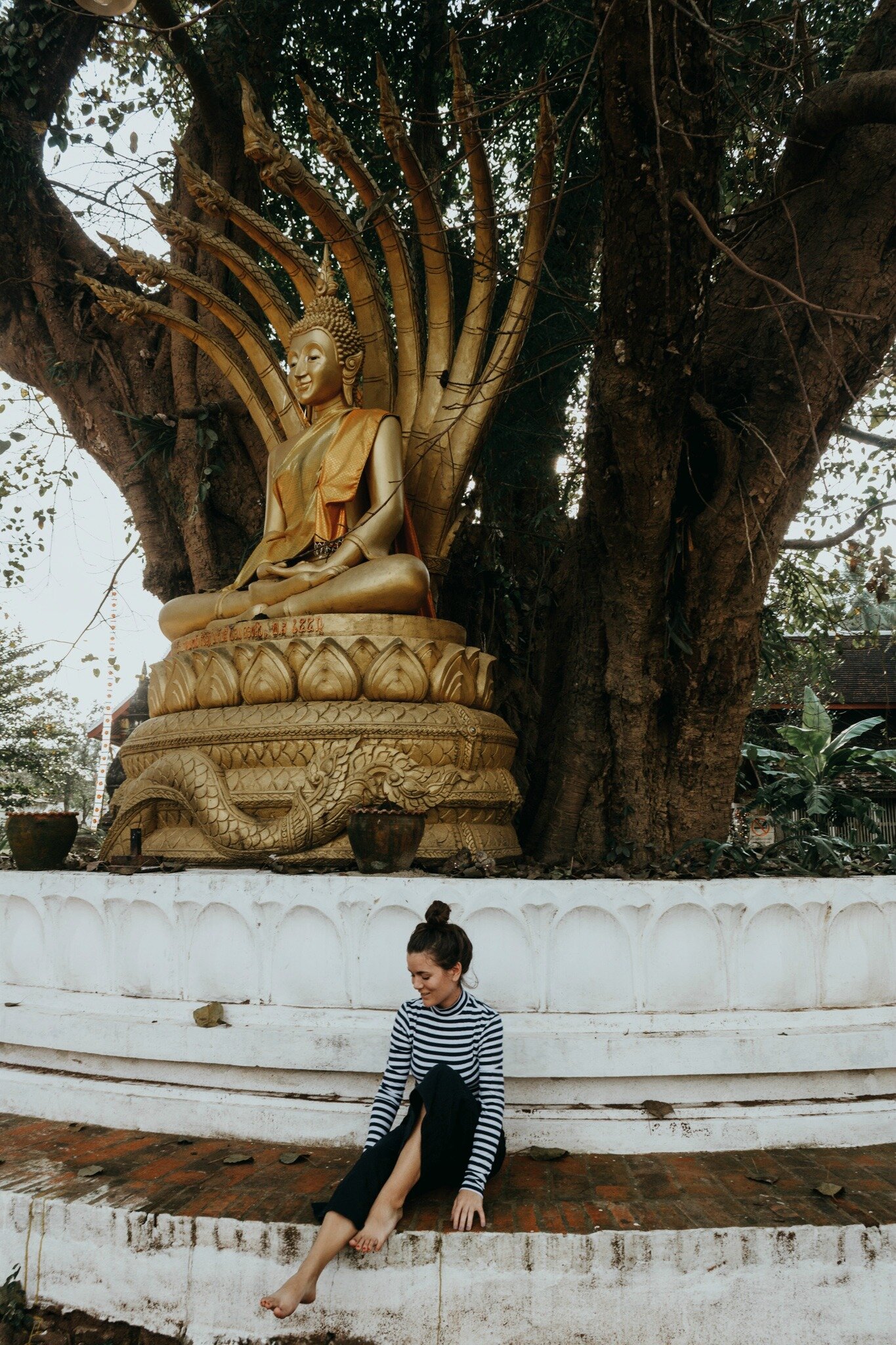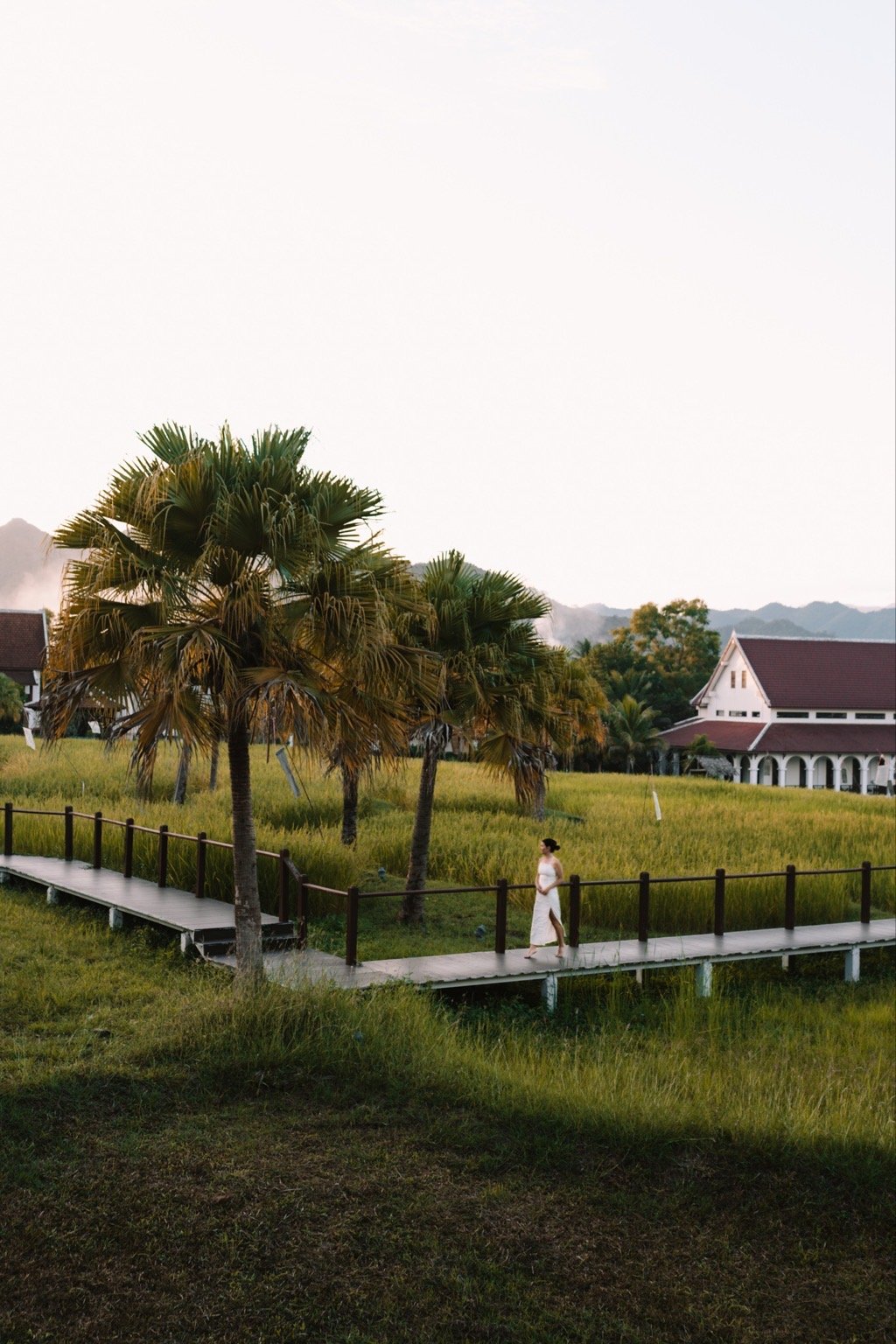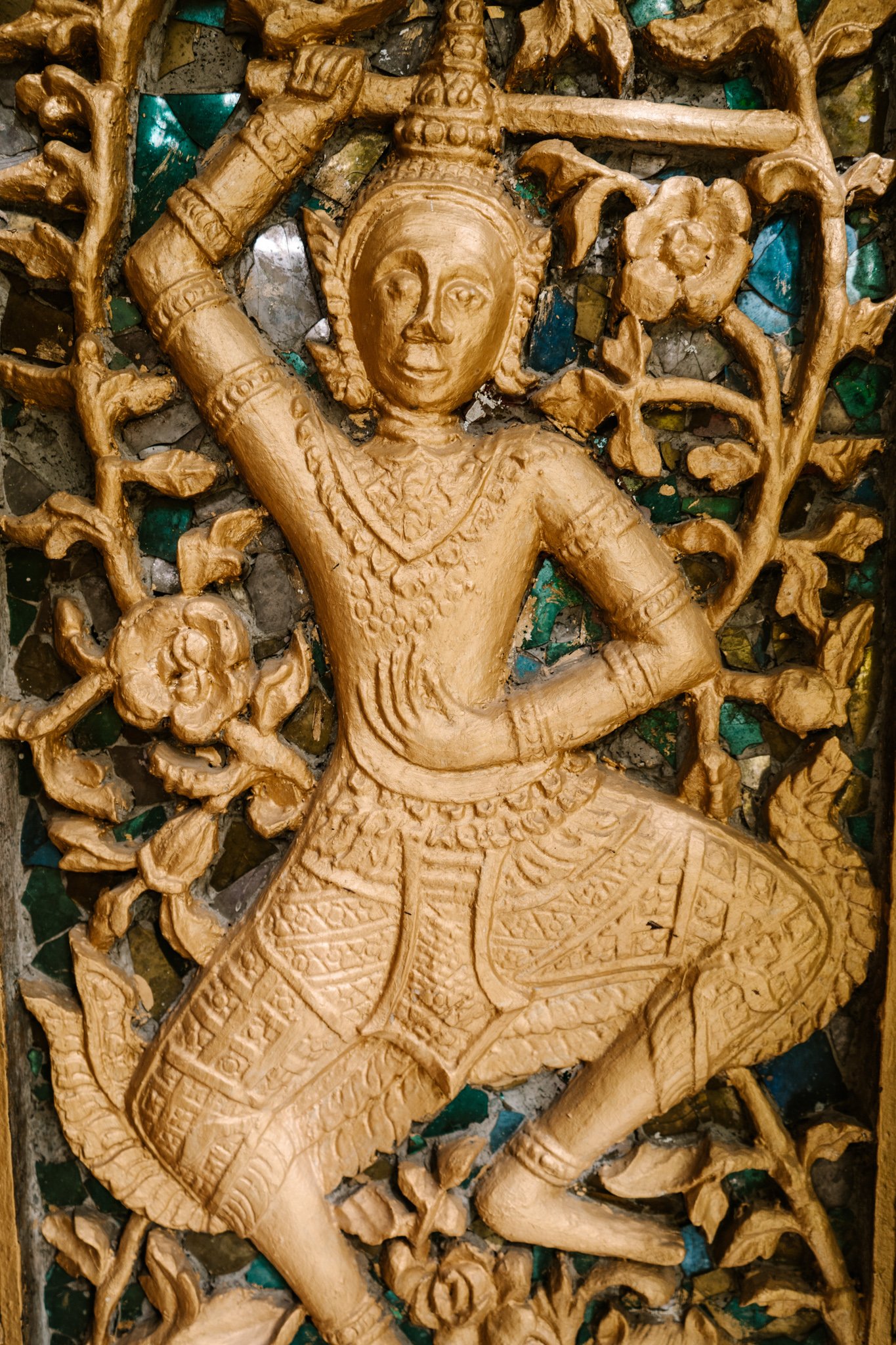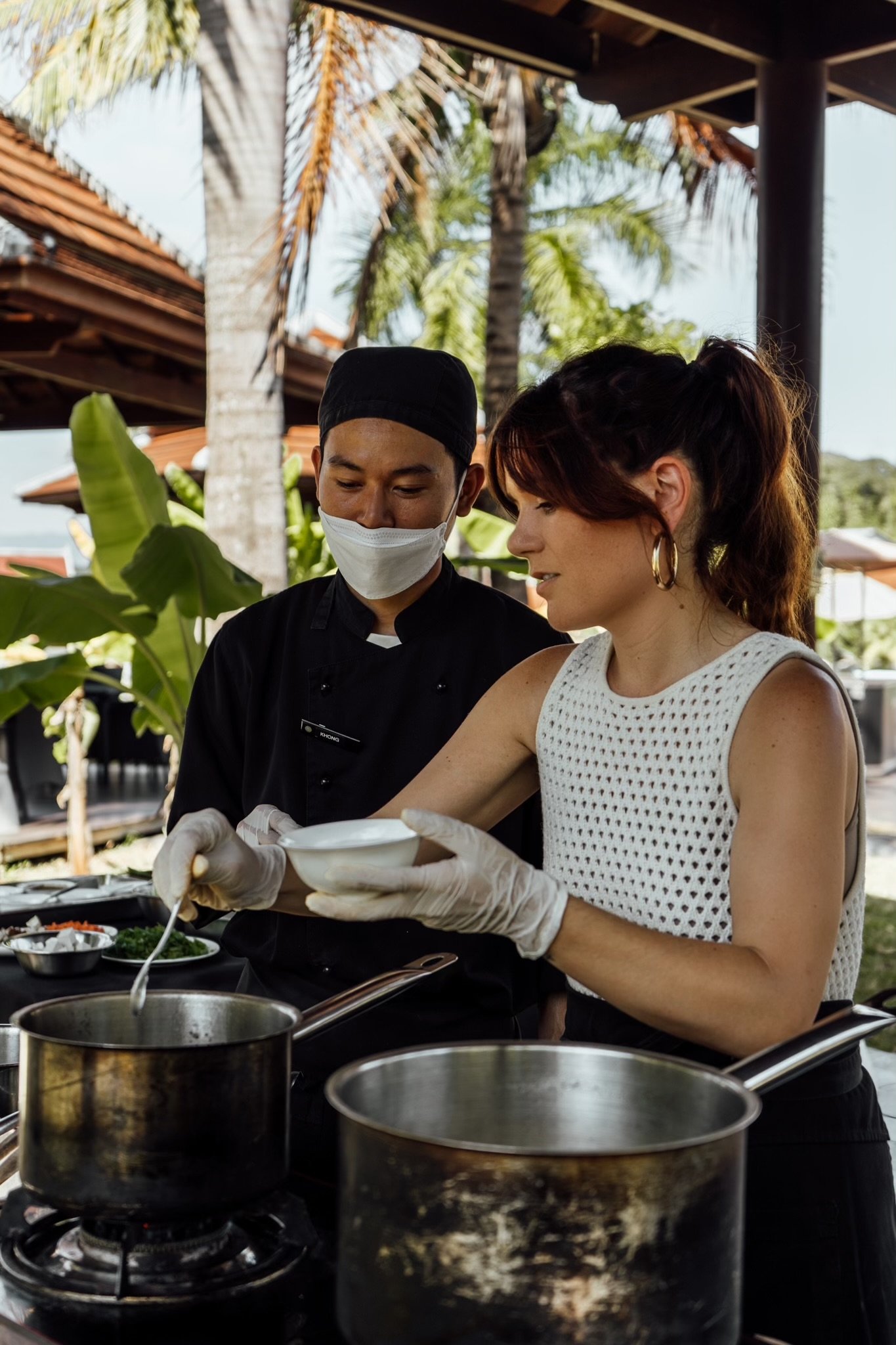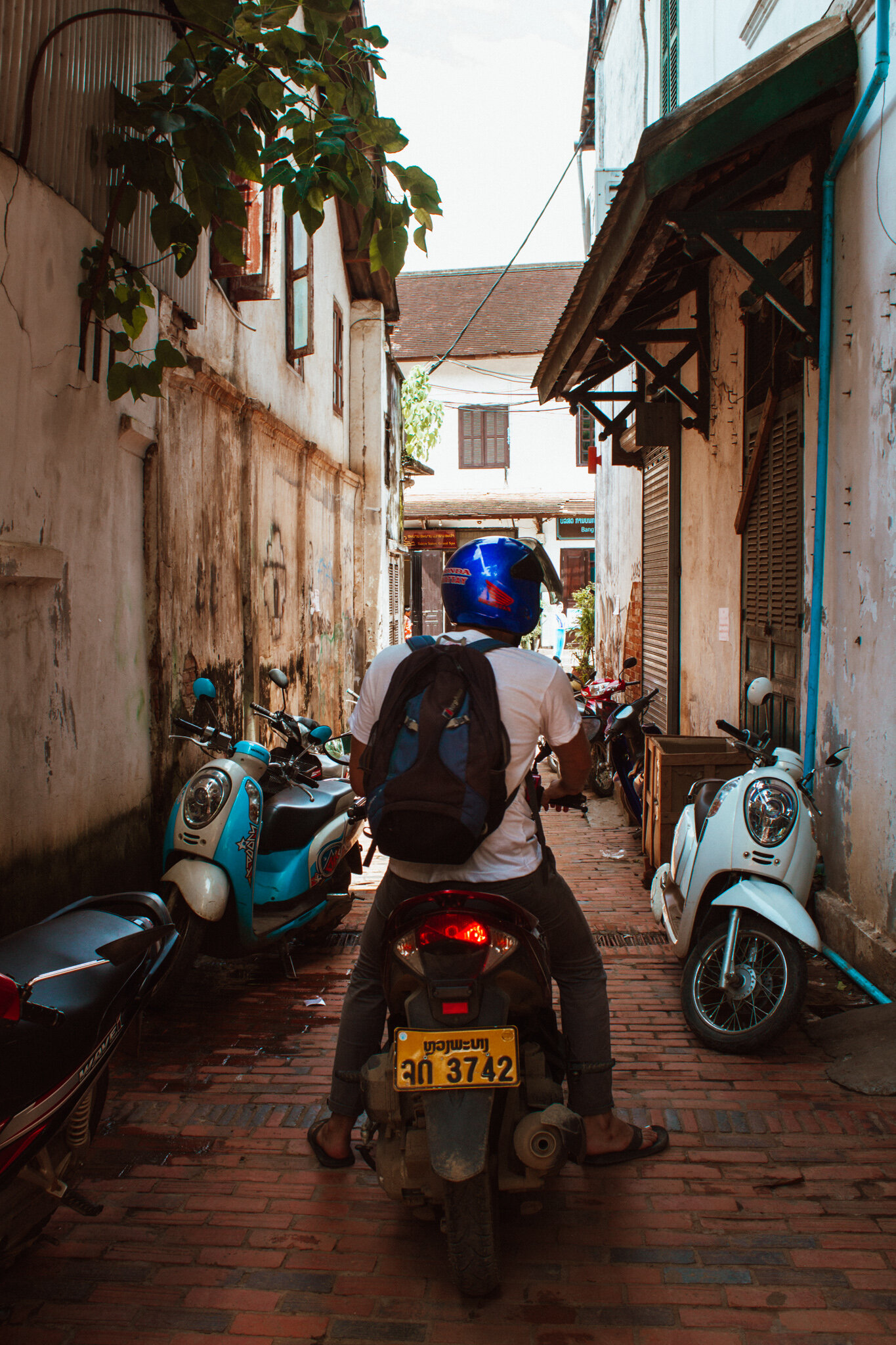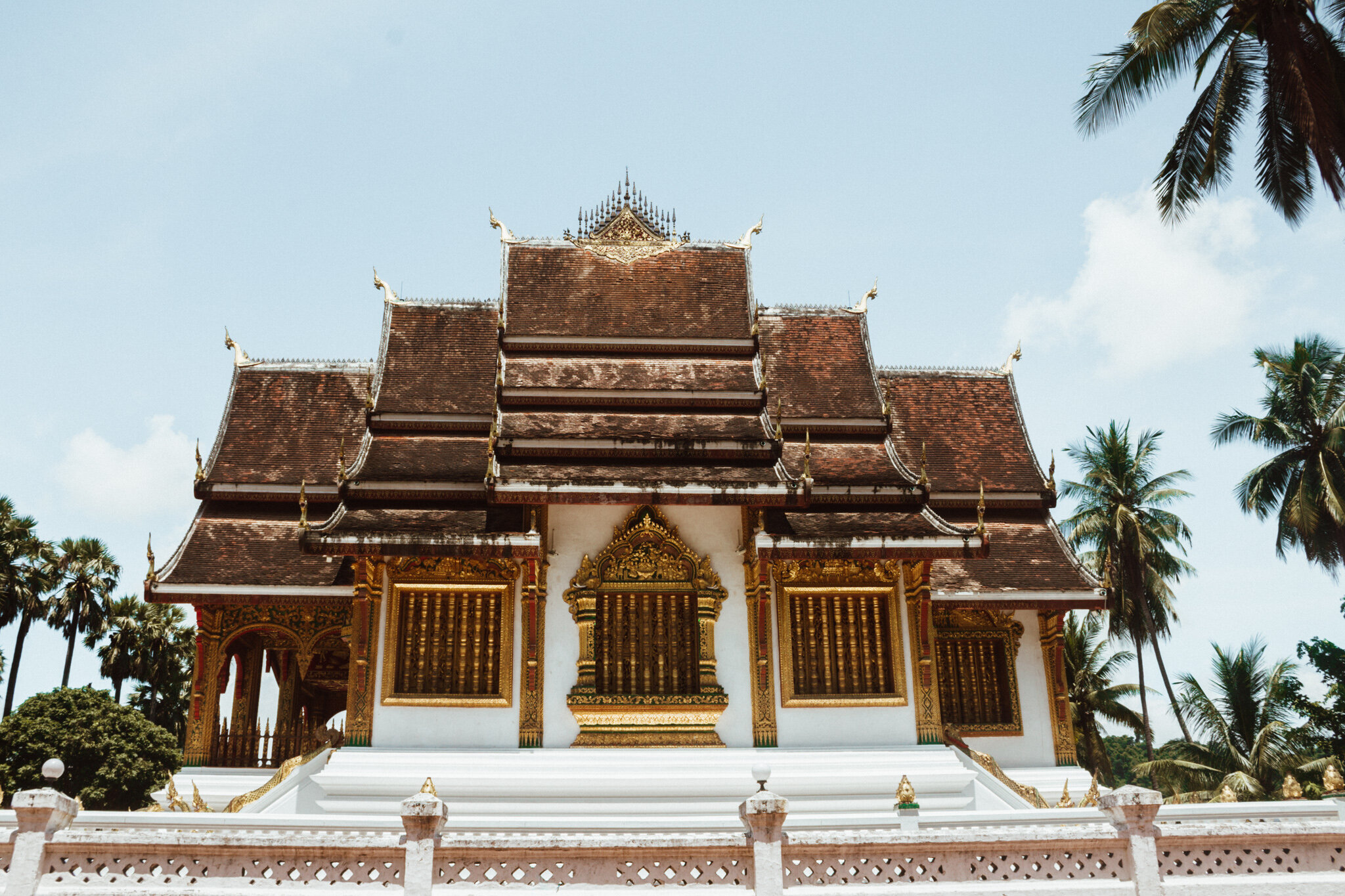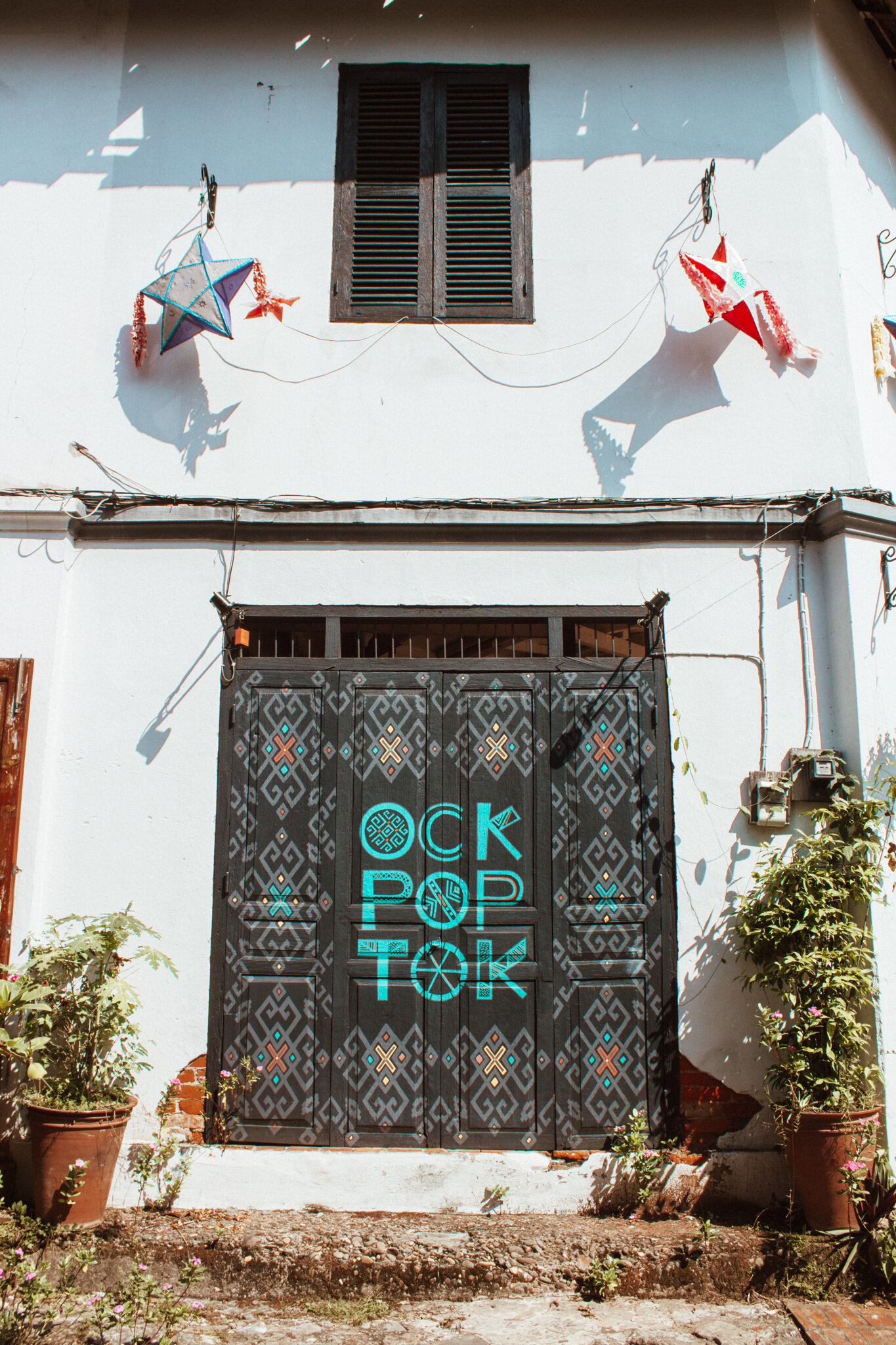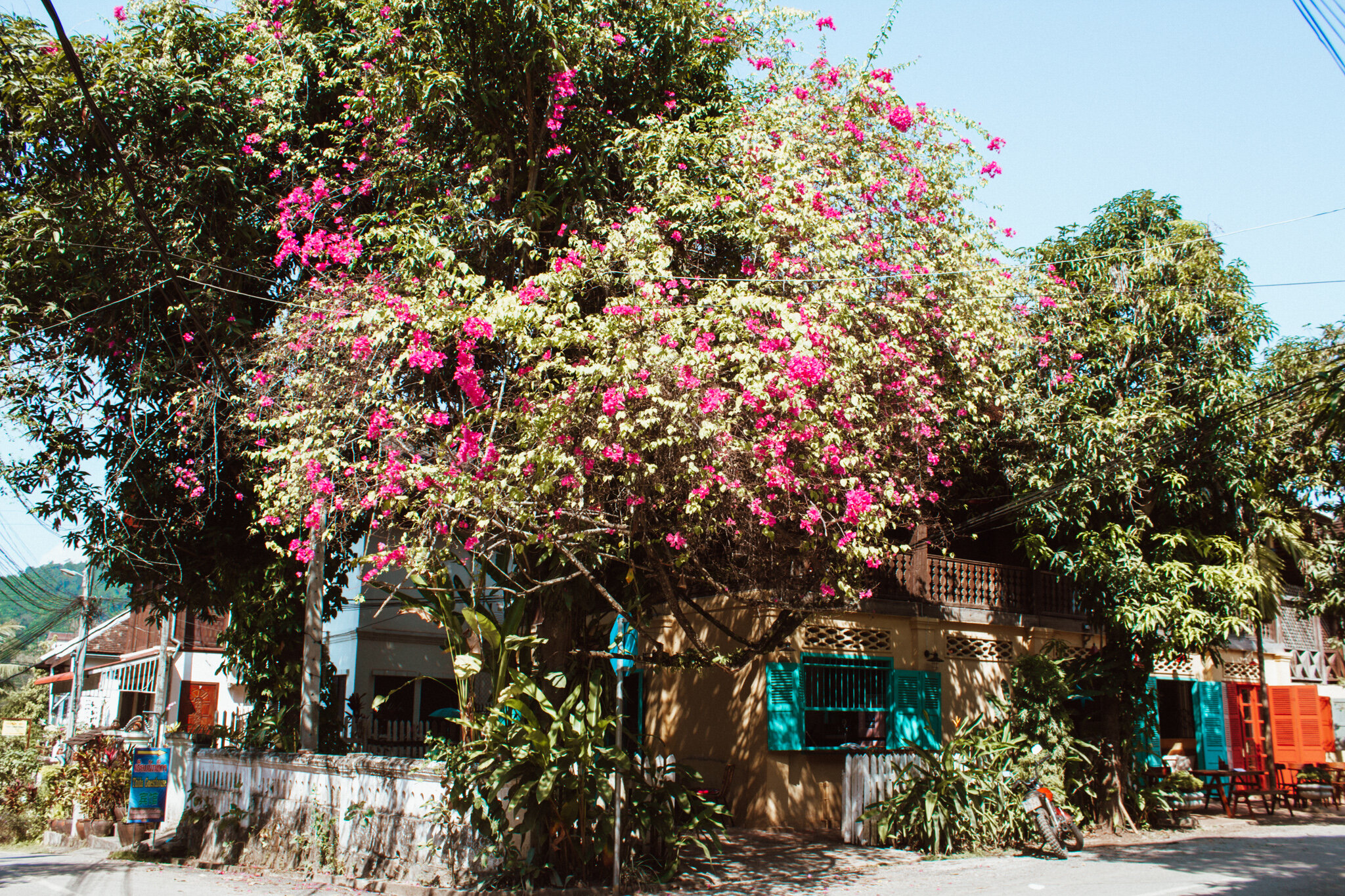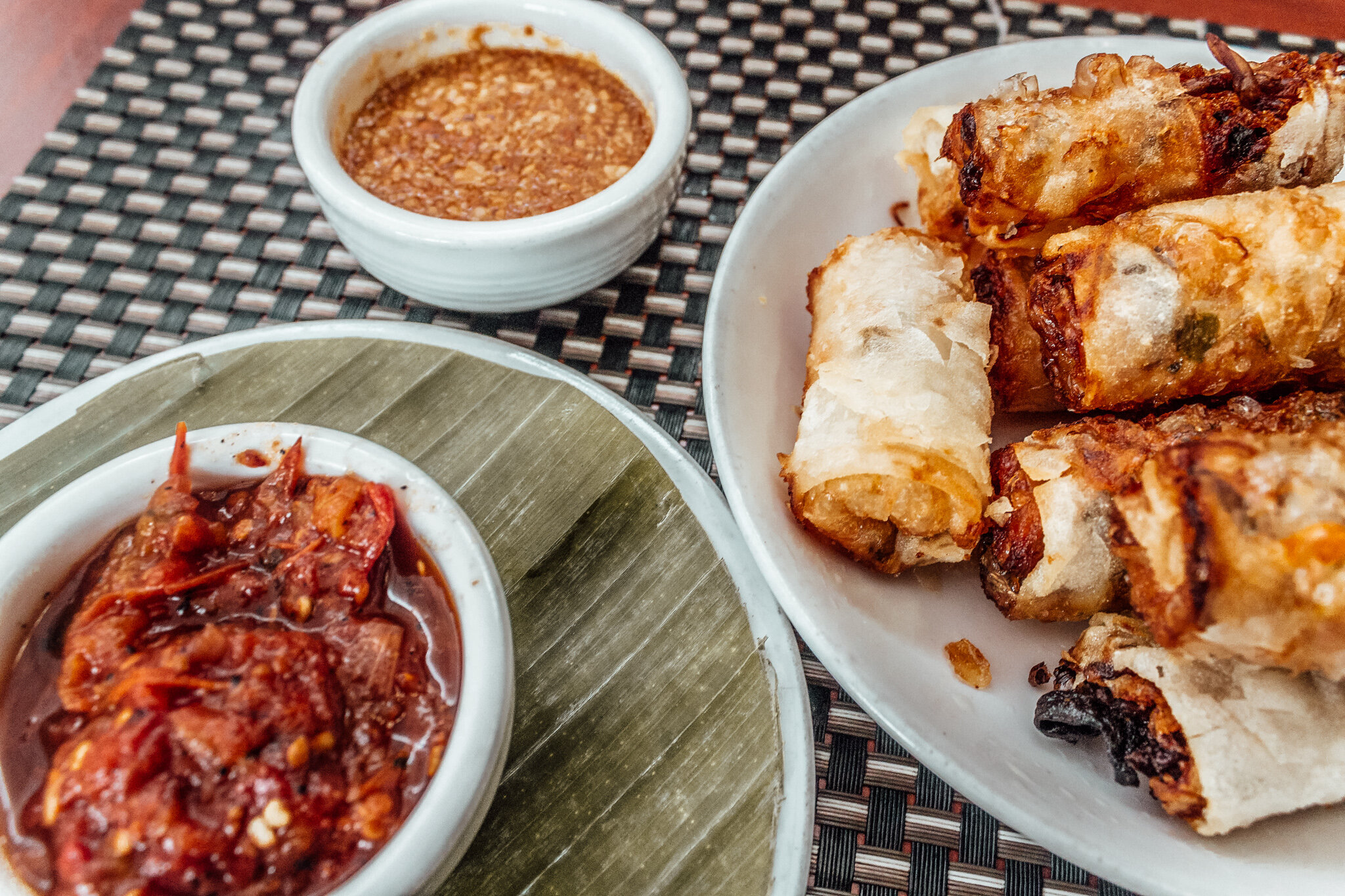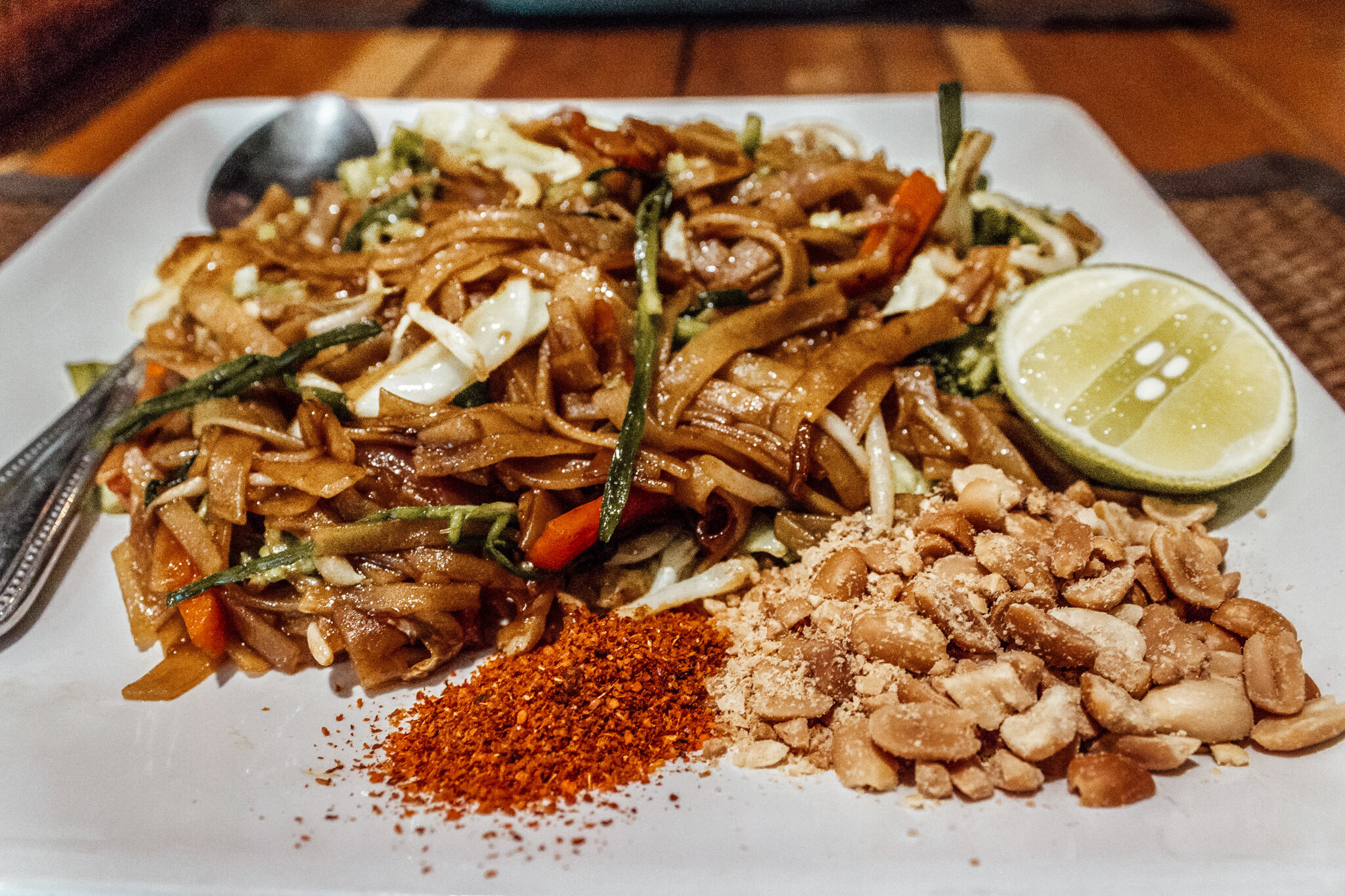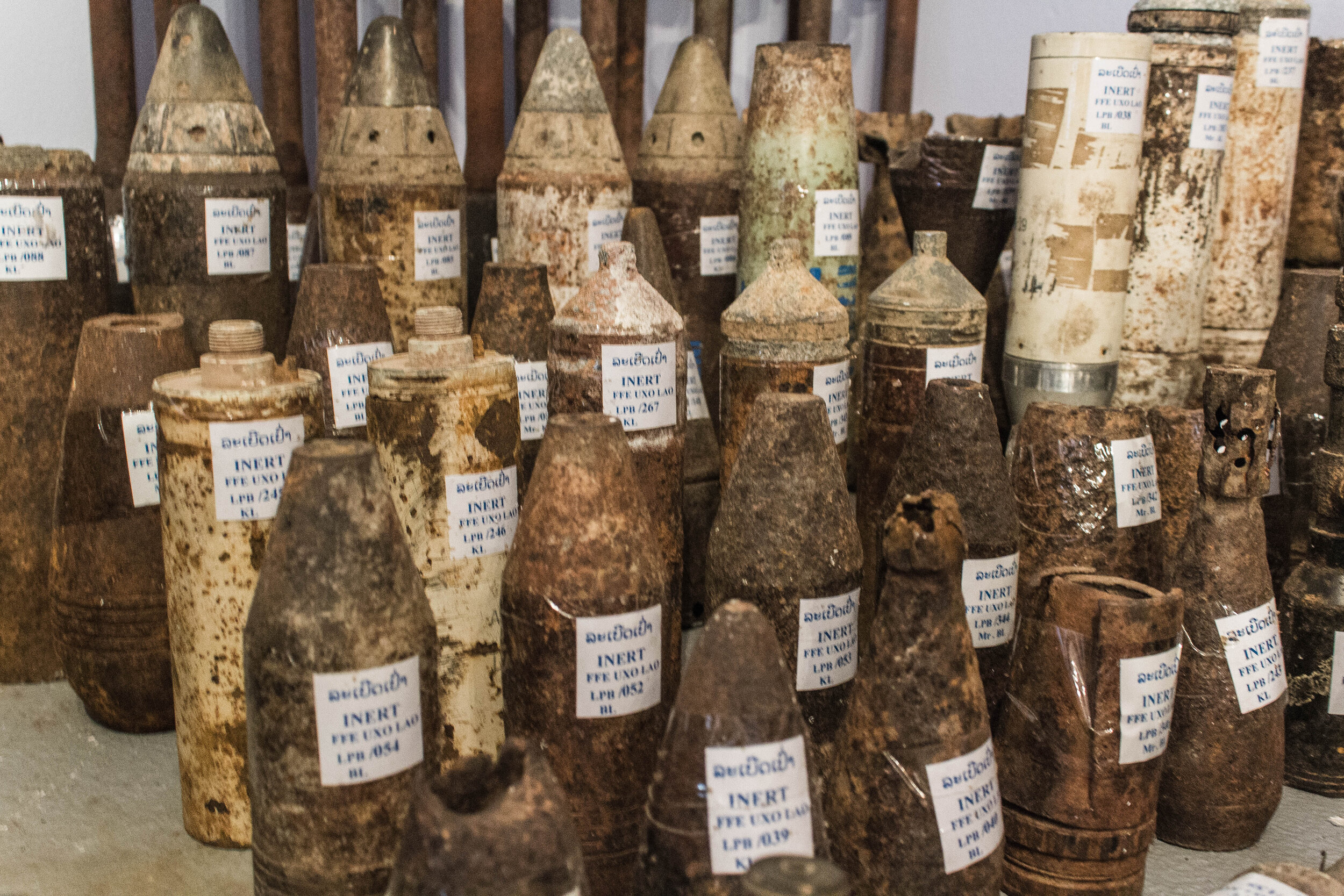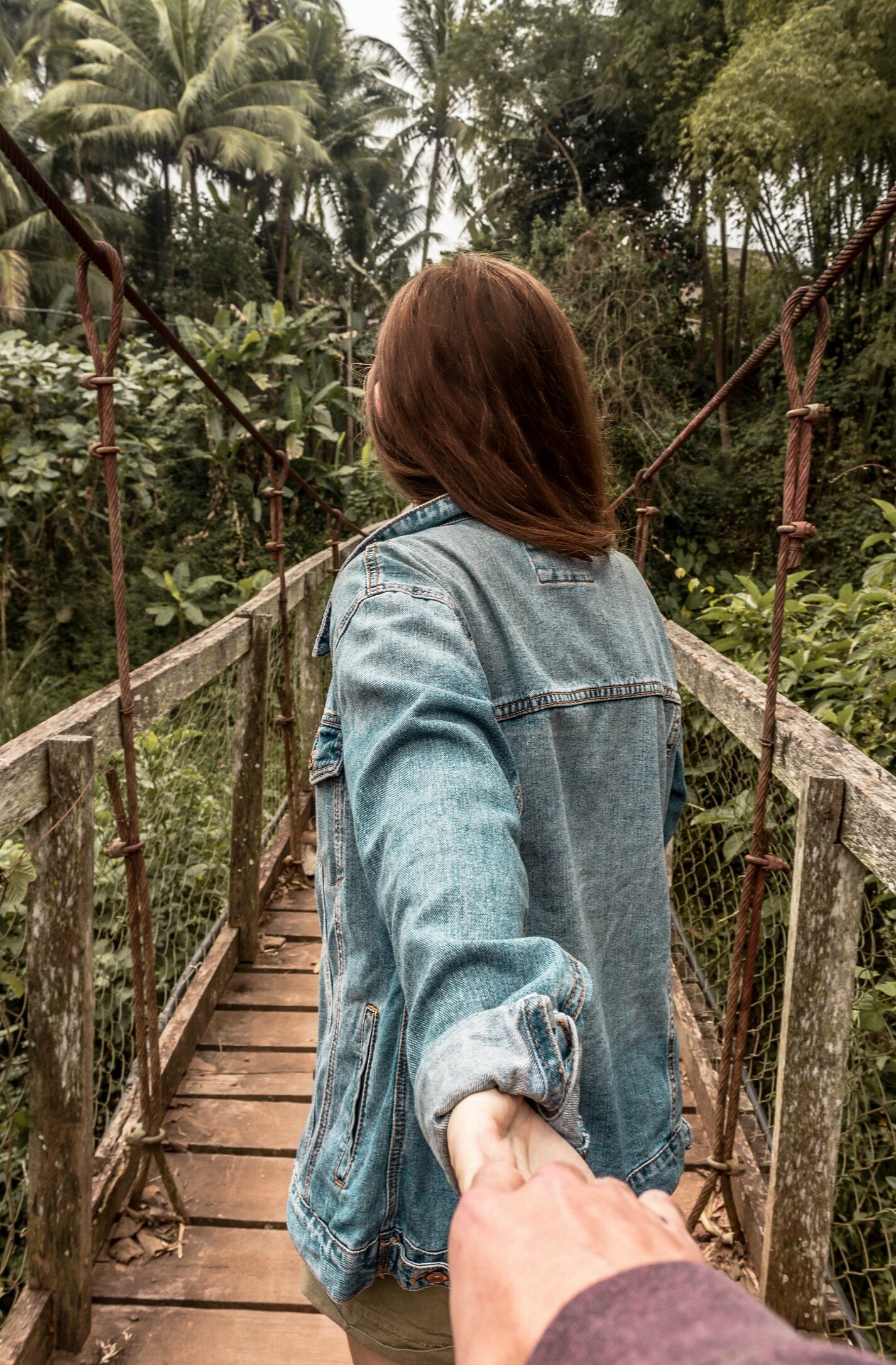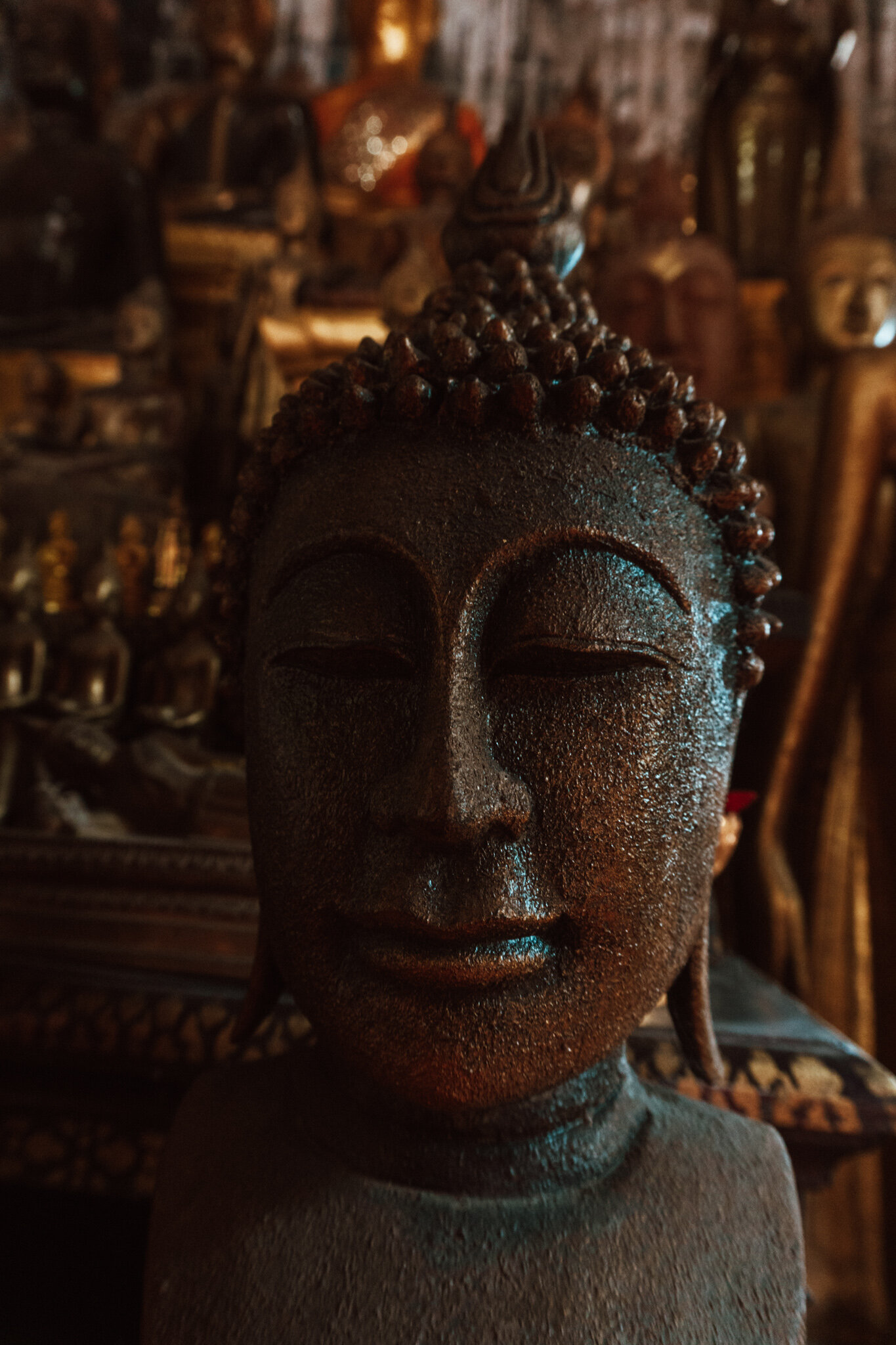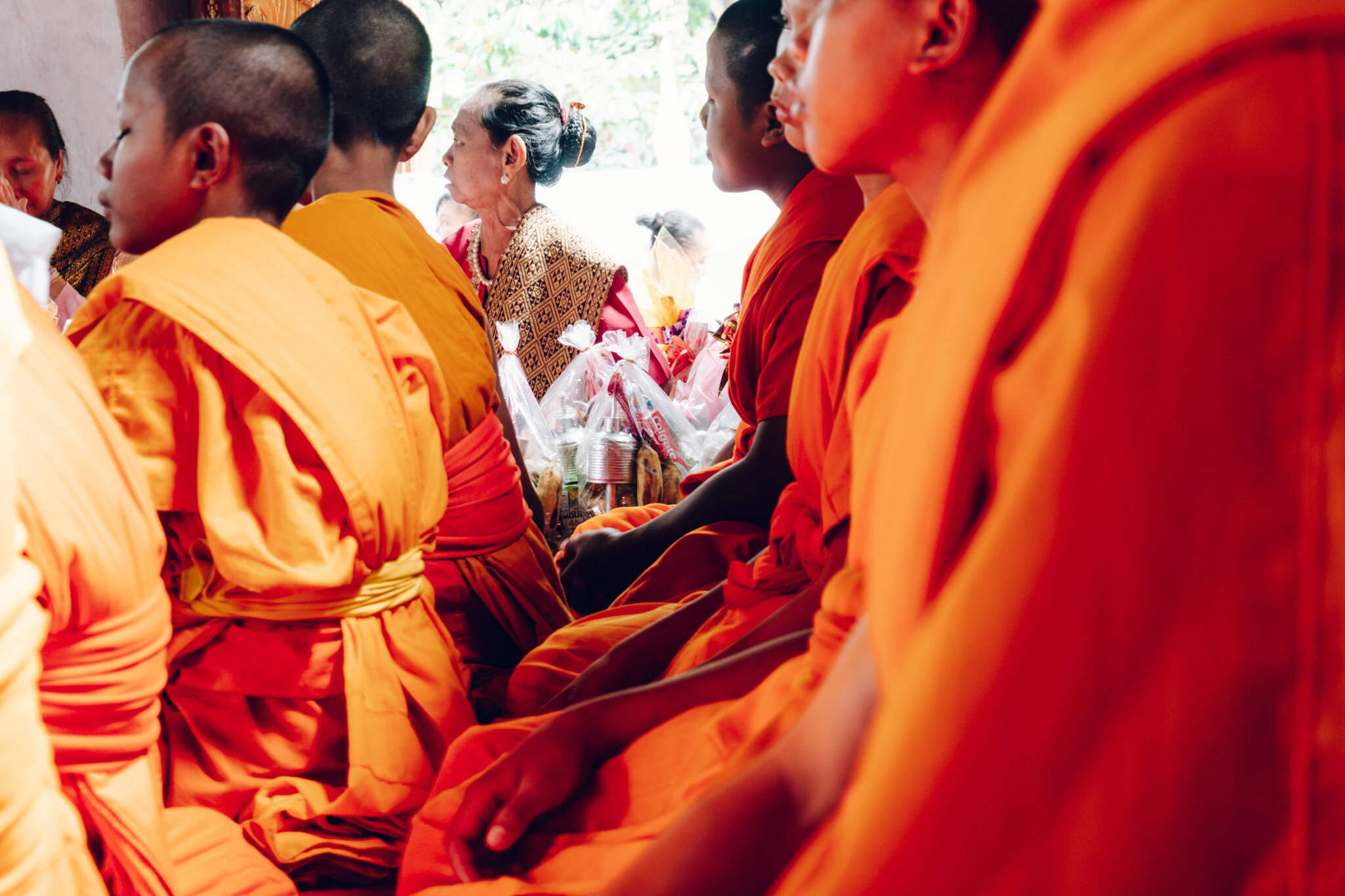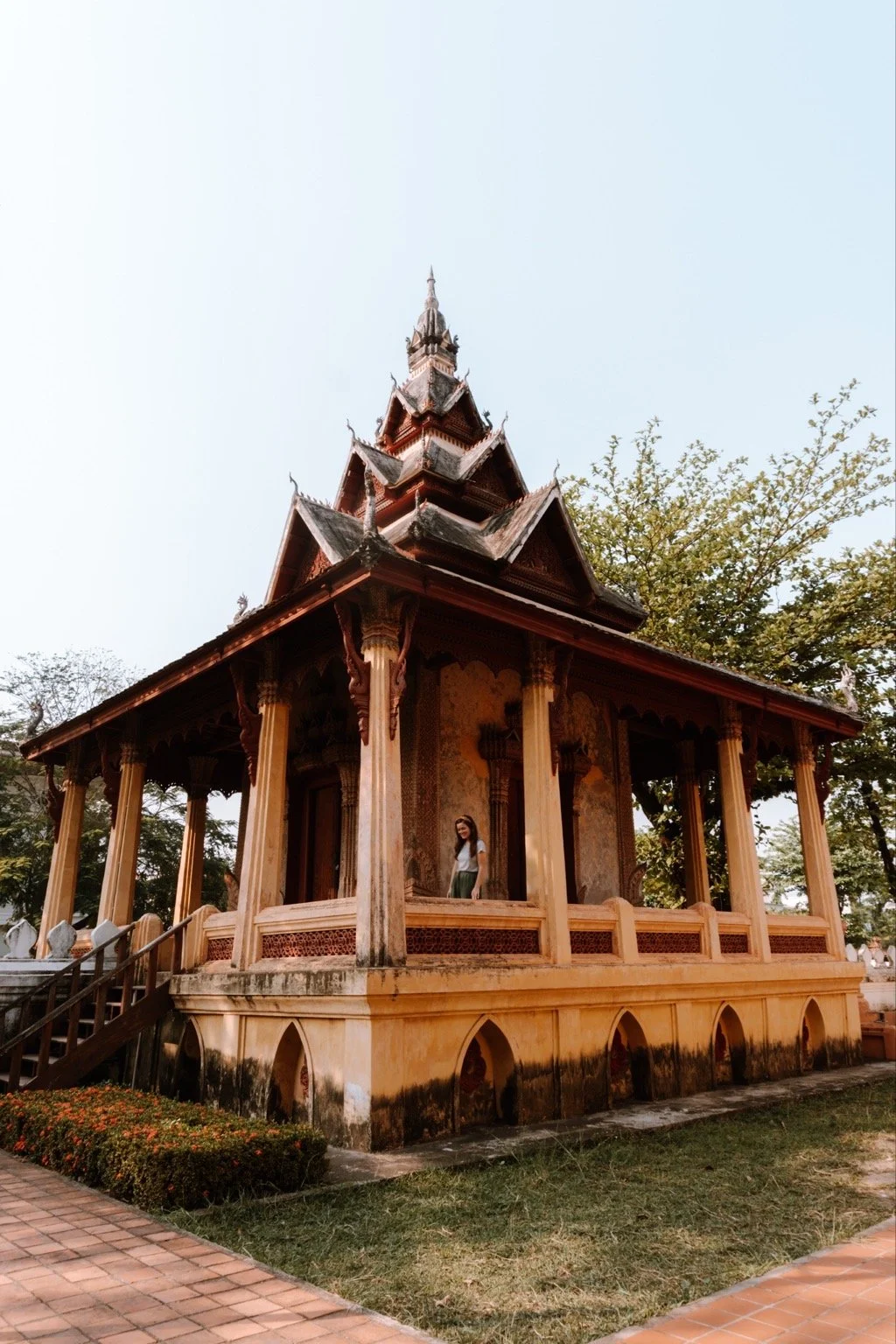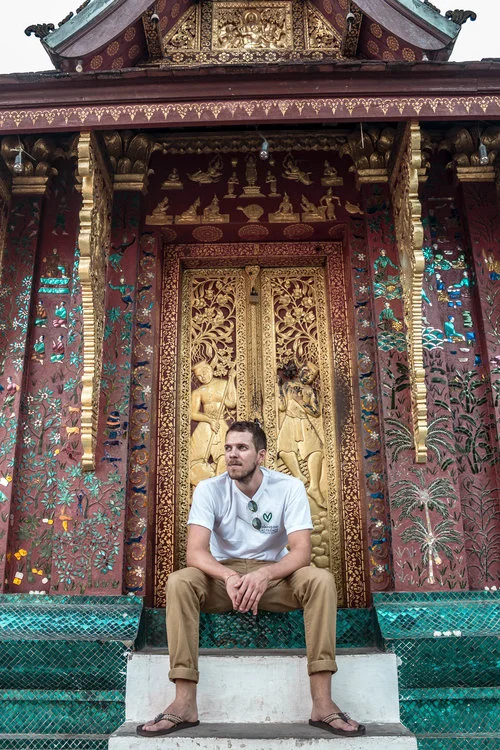23 Unique Things to Do in Luang Prabang, Laos: The Ultimate Travel Guide (updated for 2025)
Luang Prabang is a must for any Laos itinerary. The UNESCO town is absolutely buzzing with things to do. You won’t find a more thorough guide to Luang Prabang, Laos— I promise. I’ve compiled years of adventure in Luang Prabang into this comprehensive guide of unique things to do.
This isn’t your typical “go to Utopia and visit the night market” guide to Luang Prabang. I lived in the glimmering UNESCO town for three years, so you can trust me when I say, those guides do not encompass the spirit of this beautiful town on the Mekong in the slightest. There are so many incredible things to do in Luang Prabang that have nothing to do with drinking, bowling, or interrupting alms-giving. Just keep reading!
Writing this ultimate guide to Luang Prabang has allowed me to reflect on the things that have changed since I first touched down, and the essence of the place. Theravada Buddhist temples, French–Indochinese buildings, and a rich history are all visible on the surface of Luang Prabang, but it’s the underlying magic that people passing through have to slow down to feel deep in their bones.
The magic I’m speaking of is exactly what I try to capture every time I write and rewrite this guide. And I have written and rewritten it all a ridiculous number of times. It never feels quite right. I post it hoping to share my love of this place, a place in the world that saved me from being utterly lost in a sea of purposelessness, and then take it down for fear that I’ve not nailed how special it is in words.
Perhaps Elizabeth Gilbert wrote about Luang Prabang best here. It's magical.
Laos isn't quite the hotspot that its neighbors, Thailand and Vietnam, are and all those places are well worth a visit. But, perhaps it’s because Laos is a place people tend to skip over that I fell in love as soon as I stepped out into the thick, jungle humidity.
Laos didn’t steal my heart; I gave it willingly.
I want to get it right so that everyone falls in love as deeply with Luang Prabang as I did, but I also selfishly want to keep it ‘my own’. To know it as intimately as I do, is to love it for every dirt road, every power outage, every night market scam, and every morning coffee on the Mekong. To know Luang Prabang, to really know it, is to love it. And I hope you do.
a brief history of Luang Prabang ↴
Luang Prabang’s history is a bit confusing and contradictory. However, according to the books, the earliest recorded Lao settlers were those who dwelled in the Nam Ou Valley around the 10th century. According to local folklore, Khoun Lo led a migration of Lao people to Luang Prabang. By the 13th century, Luang Prabang became a thriving center of artists and merchants.
The city has survived French colonization, Japanese invasion, and U.S. bombings. Finally, in 1995, Luang Prabang became a UNESCO World Heritage Site “for its remarkable preservation of architectural, cultural, and religious heritage.” Today, it has grown to become a city known for its relaxing pace of life, its stunning temples, and its beautiful Mekong golden hours.
best time to visit Luang Prabang↴
October. I’m saying this with every bit of certainty that you must visit Luang Prabang during the Festival of Lights, which typically takes place at either the very end of September or early October. Dates will vary, so make sure you plan your trip accordingly.
If October is completely out of the question for you, November to March is the coolest time to visit. From March to May, temperatures will reach well over 40°C and the humidity makes the air heavy.
June to September is the rainy season. There can be flooding, which makes the famous waterfalls less “blue” and sometimes means they are closed off completely. That being said, the rainy season really isn’t as bad in Laos as it is in other places. It usually pours rain at night, is fine in the mornings, rains again once in the afternoon, and then is fine again until dinner time. As long as your itinerary is flexible, it’s actually is fun time to visit the city because there are fewer tourists and the temperature isn’t scorching.
Laos visa requirements ↴
Visitors to Luang Prabang have to first make it into Laos, which requires a tourist visa that is good for 30 days. You can obtain a visa one of two different ways:
1. visa on arrival
A Laos Tourist Visa is available upon arrival at the airport and is valid for 30 days. From the plane, you’ll wait in the visa line and pay a fee based on your country of origin (or wherever you have a passport from). This fee ranges from USD $30 – $42. There is also a $2 processing fee. In addition to cash, you’ll need to provide a passport photo. If you haven’t brought a passport photo with you, you’ll have to pay another USD $1 for them to copy your passport’s photo page.
The visa lines in Luang Prabang and Vientiane airports sometimes look very long but, in my experience, they typically move quickly. To avoid this, consider applying for the new Laos E-Visa (information below).
What you need for a visa on arrival:
1 passport photo- if you don’t have these, they will make a copy of your photo for you for an additional fee
a minimum of USD $45 in cash- the bills must be clean, crisp, and in near-perfect condition
a passport that is valid for 6 months past travel dates and has at least 2 full pages, the visa will take up an entire page
2. e-visa
Laos now has an e-visa for travelers to pick up before they arrive in the country. The E-visa is a more expensive option since it costs USD$50. The benefit is that it will eliminate the on-arrival visa queues. It is valid for a 30-day visit.
To obtain a Laos E-visa, fill out the form and application online via the Laos e-visa government website. Next, upload a clear passport photo and a picture of your passport’s bio page. This takes approximately 3 business days to hear the visa determination (if you’ve been granted the E-visa or not). You’ll then be sent an official approval letter to be printed off and brought with you to the airport. You have to enter Laos within 60 days of receiving your approval letter, so plan accordingly.
You can enter with the e-visa through the following airports and land crossings with the E-Visa:
Vientiane
Luang Prabang
any of the official Friendship Bridges (land border crossings)
Pakse
getting to Luang Prabang ↴
via Luang Prabang Airport
There are relatively affordable flights into Luang Prabang from Hanoi, Vietnam, and Bangkok, Thailand, via airlines like Lao Airlines, Vietnam Airlines, and AirAsia. If you arrive to Luang Prabang by plane, you will need to pay 50,000 LAK for a van ride to your accommodation in the city, unless you have previously arranged pick-up with your accommodation or hired a driver prior to your arrival. This fee is non-negotiable. You have to pay cash at the kiosk near the exit doors and you’ll be given a ticket. A driver will take your ticket, lead you to a van, and once the van is full you will be driven to your accommodation.
via Mekong River slow boat
The slow boat along the Mekong from Thailand to Laos is a popular way of getting to Luang Prabang for backpackers and anyone a little more adventurous. In all my years living and working in Laos, I’ve never ridden the slow boat. That’s because, as its name suggests, it takes a c h u n k of time. I’ve heard a lot of people rave about the scenery and others say that after the first few hours cabin fever sets in. I suppose, like anything, it depends heavily on your personality. However, if it’s something you’re interested in, you can arrange your slow boat arrival from multiple travel agencies and boat companies in Thailand.
via train
The new railway in Laos is the topic of much-heated debate, but almost everyone agrees that it is rapidly transforming travel in Laos. For more information on the train system in Laos, read my article here.
via domestic bus
Already in Laos? Cool! There are plenty of domestic “buses” from all over Laos that will get you to Luang Prabang. You can buy your ticket at any bus depot. Alternatively, most hotel reception staff can help you arrange bus transportation to Luang Prabang.
getting around Luang Prabang ↴
I suggest to either explore by walking, renting a bicycle, or hiring a motorbike. However, some visitors with more jingle in their bank might hire private drivers or utilize tuk-tuks.
walking
Seeing Luang Prabang via walking means transportation is free! Walking is also a great way to understand the lay of the land. If you are walking, be extra sure to wear sunscreen and bring water with you wherever you go— Laos is infamously hot and there is little shade to be found in the center of town.
bicycle
Pedal bikes are a great alternative for those visitors who want to get around faster than by foot, but are a little iffy about motorbiking. Bikes are available for rent all over town, and most hotels and hostels offer bicycle rentals to their guests. You can also venture to the main street for a bicycle, but rentals are always more expensive from these hire stalls.
motorbike
For those who are a little more adventurous, motorcycle rental is available at various locations, particularly on the main road {where you'll find the night market}. Some hotels can also set up motorbike rentals for you, so check with your reception staff. Laos has no real road rules and there are crashes on the road every day. I don’t want to scare anyone out of motorbike rental, especially since we’ve owned and used a motorbike to make our life easier in Luang Prabang.
Read more | Renting a motorbike in Laos: questions to ask + things to consider
tuk-tuk
Tuk-tuks line the main street, but I would advise against jumping into one of these. These main street tuk-tuks regularly rip off tourists, thus them being on the city’s most backpacker-saturated road. If you must take one of these tuk-tuks, at the very least attempt to barter. Otherwise, I suggest walking away from the Mekong and the city center towards the Nam Khan. These drivers tend to be a little more up for negotiation.
private driver
Private drivers can be arranged with the concierge staff at any of the hotels and resorts in Luang Prabang. Not staying anywhere luxe but want to splurge on a driver? That’s easily done too! Luang Prabang is a small town. Most hostels and guest houses have a driver contact or can point you in the right direction. Make sure you agree on a price before you jump into the passenger seat— otherwise, you’ve positioned yourself without bartering power.
Lao phrases to know ↴
Lao is the language most widely spoken across the country, but it’s important to note that There are 42 ethnic groups in Laos, and almost all of them have their dialects. However, you can get by in Luang Prabang with English and by learning a few key Lao phrases. You can get by with English in Luang Prabang, just be sure to grade your language when you speak with locals. Be mindful that English isn’t their first language and being mindful that Lao isn’t yours.
Hello : sabaidee {saah bye dee}
Thank you : khop jai {cop chai}
How much? : theoa dai {toe die}
Not going, thank you : bo bi khop jai {beau bye cop chai}
Delicious : seb lai {seb lie}
currency, money exchange, + budget ↴
The national currency of Laos is the Lao Kip (often abbreviated as LAK).
Cash is king in Laos. Lao Kip (LAK) is the local currency. I use the XE Currency Exchange app to keep up to date on fluctuations. There are ATMs for you to withdraw cash around town. Most cards have international fees, so ask your bank about this prior to your visit.
You can exchange your cash at one of the many money changer stalls around town, but for the very best rate, I go to Sue near the Mekong River. I have marked her on the map at the bottom of this post as an ATM.
Visitors often complain about the cost of things in Luang Prabang. Typically, these tourists are also the ones eating on the main street and staying near the Mekong River. Yes, Luang Prabang is more expensive than other destinations in Laos (it’s the most visited city in the country), and more spendy than neighboring countries like Vietnam. Honestly, it’s also a lot more affordable than people make it out to be. I believe it comes down to people knowing where to go or how to save.
The biggest costs in Luang Prabang are tuk-tuk rides to the waterfalls (I’ve seen people get ripped off too many times to count), eating falang (foreigner) food, and staying in accommodation close to the town center. Avoid these things and you’ll find your wallet looking larger.
where to stay in Luang Prabang ↴
There is a lot of variation in Luang Prabang’s accommodation, and it tends to be much more expensive than in other parts of the country. From budget bunks to five-star resorts, Luang Prabang absolutely has every budget covered. The most affordable options typically sit on the Nam Khan River side of the town. The general rule of thumb is the closer your proximity to the Mekong, the higher the price you’ll pay.
Because of Luang Prabang’s UNESCO Heritage standing, hotels with swimming pools are all located outside of the old city and will cost you. However, on a hot afternoon in Luang Prabang, there really is no better place to be than in the water, ya dig?
As always, these are all guesthouses, hotels, and resorts I’ve stayed in personally.
mid-range stays
Cold River - under new management since I last stayed here
Le Sen Boutique Hotel - an eco-focused hotel that’s Lao-owned and operated - read my full review here
luxury hotels
Sanakeo Boutique Hotel + Spa
We love using Booking.com to book the best places to stay around the world.
where to eat + what to try in Luang Prabang ↴
There is heaps of good food in LPB. For a wee little city, there's a lot of variety too. And that makes sense since Luang Prabang prides itself on its food.
must-try local foods
jeow bong | sweet or savoury chilli paste made with galangal, garlic, sundried chilis, and fish sauce {among other things}
tam màk hung {papaya salad}: Luang Prabang has created a signature style of this Southeast Asian classic using crab juice to give it a unique local flavour
khai paen | river weed that’s been laid in the sun to dry, typically sprinkled with sesame seeds
sticky rice | variety of rice grain that is more starchy than typical steamed rice
lao lao whiskey | locally produced, non-regulated alcohol that is used regularly to clean classroom whiteboards
khao piak sen | crispy sliced pork, blood cake, noodles, broth, morning glory greens
where to eat non-Lao food
Buoang- $$
Le Banneton- $
Formula B - $$
Opera House - $$
Pizza Phan Luang - $$$
Secret Pizza - $$$
Popolo Cantina - $$$
Yuni Yupoun - $$
Indigo Café- $$$
where to eat Lao food
Atsalin- $ any true local will tell you this is their favorite restaurant in Luang Prabang
Bamboo Tree Garden - $
Noodle Soup Shop - $ (across from Wisdon Mystery Hotel near Wat Xieng Thong)
"Sandwich Ladies"- $ the famed “Sandwich Ladies” line the street near the library, but it's not the official name of the street stalls (marked as “Sandwich + cafe” on the map)
what to see + do in Luang Prabang ↴
take a bike ride to the 'Paper Village'
One of my favorite days in Luang Prabang was spent biking around Ban Xang Khong, the “Paper Village”. It's only a short bike or tuk-tuk ride from Luang Prabang to the village where you can see locals crafting beautiful handmade paper and weaving vibrant sinh. There are restaurants and temples in the village that make for a beautiful afternoon excursion.
visit one of Luang Prabang’s many waterfalls
Kuang Si Waterfalls might be the most well-known of Luang Prabang’s natural landscapes, but it shouldn’t be the only one you make the effort to visit. Here are the three I recommend, all for different experiences:
Kuang Si Falls | Kuang Si Waterfalls are a 45-minute tuk-tuk ride from the city. There are many posts on SLK about my visits to Kuang Si. You can read the most recent one here.
Tad Thong Falls | Want to get completely off the beaten track? Tad Thong is the spot for you. There is very little runoff here during the dry season, but it makes for quite the adventure anyway.
Tad Sae Falls | Ta Sae Falls has a lot more space, as most tourists crowd around Kuang Si (understandable). The process of getting to Tad Sae feels like an adventure in and of itself, and the pay off is a gorgeous pool of blue water sitting under thundering waterfalls. Found out how to get to Tad Sae Waterfalls here.
observe early morning alms
Luang Prabang is the spiritual capital of Laos, and giving alms is a beautiful ritual that is part of the country’s Theravada Buddhist heritage. During the years I spent living in Luang Prabang, almsgiving morphed into a sideshow for tourists. I’ve seen travelers snapping photos of Novices (who are children) without consent, watching too close to the ceremonial line of orange-clad boys. I witnessed tourists dressed inappropriately participating in the giving of sticky rice and cookies, unaware of the rules or the cultural context.
In short, people now give alms to tick it off their bucket lists, unaware of the deeper impact. Some locals are so upset about the spectacle that almsgiving has become that the city has threatened to eliminate the ritual from specific areas altogether. Please be responsible and help maintain the integrity of the almsgiving practice by observing from a respectful distance, if you feel called to do so.
My advice for those observing:
Turn the flash of your camera, as well as any shutter sound, off.
Wear conservative clothing, like you would to visit the nearby temples.
Stand on the other side of the road, to allow the Monks and Novices space.
Avoid the main street! Watch almsgiving near Wat Mano or Wat Visoun for a less circus-like experience.
have a language exchange at Big Brother Mouse
Big Brother Mouse is an organization that was originally created to promote literacy. Here, local people can go to practice their language skills in free conversation exchanges. This isn't confined to English, you can help those learning Spanish, German, or other languages. It all just depends on the needs of the students that day. Big Brother Mouse is a drop-in volunteering center, meaning you literally just stop by and sit down. If the place is too crowded, the person running the center that day might tell you to come back later. This is a great way to speak with locals and help them become more fluid in whatever language they are studying. It's a free way to give back and meet locals.
Along with conversational exchanges, BBM produces books in Lao for locals to practice and develop a love for reading. Books are still a rare commodity in Laos, giving anyone who can read a leg-up on opportunity. BBM is a Lao-owned non-profit and promotes tourists taking books on treks through villages rather than the standard sweets.
Please dress conservatively there are almost always Buddhist Monks and Novices at BBM.
take a pottery workshop in Chomphet
Lao Pottery House started its tours in 2018. For tourists who are eager to learn about traditional pottery techniques can embark on their half-day excursion. The tour includes a meal and transport to and from your accommodation. Tours run for 4.5 hours and cost USD $39 per person.
BOOK | Lao Pottery House
visit the UXO Museum
This free museum is super high on my list of things you should do for one really important reason. I was shaking while sitting in the theater at the museum watching the film clip. Between 1964 and 1973, the U.S. dropped more than 2 million tons of explosive ordnance in an attempt to block the North Vietnam troops from transporting arms through Laos. 30% of them never exploded. Want me to bum you out harder? Over 20,000 Lao civilians have been killed or injured by these UXO. What's even worse? 50% of the victims of these UXO are children. UXO Clearance is something the U.S. owes Laos. While Obama made steps, we're once again late to make amends for a nasty mess we made. Please go visit. Watch the video. Make a donation if you can. Luke took me in 2016 for the first time and I was shocked and appalled.
take a cultural temple tour lead with Orange Robe Tours
Orange Robe Tours is a profit-for-purpose social enterprise created by my partner, Luke. Every tour sold is led by a former Novice or former Monk so that they can share their expert knowledge of the dharma, their personal stories from time spent in the temple, and so that they can continue to utilize the language skills they spent years acquiring. Profits go toward dignified wages for the company’s local manager and tour guides. Anything left over goes directly to the temples that work with us.
get lost in Luang Prabang's old city
Ironic, since you really can’t get lost. The “old city” is often referred to as the “French side of town” due to its colonial buildings from the French colonists and the number of delicious bakeries that abound. There are four streets that run parallel to the Mekong with heaps of cute alleyways and mini-lanes to keep you discovering hidden gems forever. Even after living in Luang Prabang for years, I continually found little streets I didn’t know existed, giving way to cafés and shops.
get lost outside the old city
The old city may have everything right in one concentrated spot, but once you leave the center of the town, you’ll discover temples you never found in a guidebook, food that truly rates, and glimpses of life outside of the hospitality bubble. Farmers in their fields. Shop owners taking naps in their hammocks waiting for someone to purchase something. Babies sitting on the dirt road playing with scraggly-looking dogs while their mothers cook over a fire. These scenes are my favorite from Luang Prabang and they are the ones I hold onto most closely.
check out the Royal Palace Museum
The Royal Palace in Luang Prabang is a treasure trove of artifacts and history. You’ll need to be dressed conservatively, and this is strictly enforced by the ticket-selling staff. You’ll gain insight into royal life in the former capital and how the royal family once spent their days.
take a cooking class
Lao food is loosely similar to northern Thai food but somehow remains uniquely its own. Taking a cooking class in Luang Prabang is a great way to gain cultural context.
My first time in Luang Prabang, my friend, Grace, and I decided on a cooking class with Bamboo Tree for a few simple reasons: 1) it was slightly cheaper than Tamarind, 2) we were volunteering until later in the day so we needed to find a class available on Friday evening, 3) we didn't need a whole day to learn about the market, as we had already been many times over our month there, and 4) there was no set menu, which meant our group of 4 was able to pick the exact dishes we wanted to learn to cook. A year later, living in Luang Prabang, I took a cooking class with Tamarind
You can book Tamarind here or Bamboo Tree here. Both come highly recommended.
Cooking classes I’ve taken in Luang Prabang that I recommend:
Bamboo Tree
Tamarind Restaurant
walk with elephants at Mandalao Elephant Conservation
I was a guest of Mandalao Elephant Conservation and loved every minute of the ethical, conservation experience. During this trek, you walk alongside elephants that have been rescued from the timber industry to finish out their days in the Lao jungle. They lead and you follow at their pace. No hooks or ropes or riding. Just you and the elephants on a stroll. Casual as. At the end of the experience, you’ll get to indulge in a delicious Lao meal along the river. It’s the perfect ending to an extraordinary adventure.
enjoy the views from Phousi Hill
Phousi is the geographical center of Luang Prabang, which feels fitting given it’s also considered the spiritual center of the city. The peak is where just about every tourist in the city can be found at sunset, eager to snap a photo (though I recommend heading to Santi Chedi/Wat Pa Phon Phao for sunset without the hordes of people).
There are three ways to get to the top of Phousi Hill. The first and most straightforward is via the stairway directly opposite the main gate of the Royal Palace Museum. The second approach, on the other side of the hill, is up a zigzag stairway on Phousi Road marked by two large nagas on either side. The third way to get up to the top involves scrambling up from Wat Pha Phoutthabat near the north of Phousi (found opposite the Saynamkhan Riverview Hotel).
Please wear clothing that covers your shoulders and knees, as Phousi is a spiritually significant place and there is a temple on-site.
zen out at a yoga class
Luang Prabang is slower paced. Take that zen energy and boost it with a class at Luang Prabang Yoga. The instructors are fantastic and I always leave the room feeling better than when I sat down on my mat. Drop-in classes fill up quickly, so make sure you book in advance if you can.
BOOK | Luang Prabang Yoga
take a coffee tasting tour with Saffron Coffee
One of my favorite coffee shops in Luang Prabang {conveniently next door to Orange Robe Tours’ office}, Saffron Coffee, hosts tours and tastings of their coffee product for enthusiasts like me, and for those who are generally interested in the socially responsible coffee business.
take a textile workshop with Ock Pop Tok
All of the textile workshops and handicraft classes at Ock Pop Tok are incredible. However, indigo dyeing specifically is something that the people of Laos have been doing for hundreds of years, so learning to naturally dye fabrics from them is learning from experts. You can book a class online, at the Ock Pop Tok shops in town, or by calling Ock Pop Tok. Each booked class comes with a free tuk-tuk pick-up from your accommodation (it’s a funky pink color with a bold neon pattern painted along the side). If you book one of the full-day classes, a Lao-style lunch is included in your booking. This is an amazing way to support an ethical business in Luang Prabang that will leave you with a one-of-a-kind souvenir.
go to a free outdoor viewing of Chang
Made in 1927, Chang is a black-and-white silent film that depicts a Lao family living in the jungle. The family has to navigate sharing the land with all sorts of wild animals, which culminates in an elephant stampede. You can watch Chang for free at one of the city’s outdoor viewing venues, the Victoria Hotel or the Sanctuary Hotel.
take a sunset cruise along the Mekong
Laos just does Golden Hour better. Need proof? Book a sunset cruise along the Mekong River with Mekong Kingdoms. I was a guest of Mekong Kingdoms and enjoyed a slow evening of snacks and cocktails while we moved with the water and watched the sun go down behind the lush Luang Prabang mountains on either side of the bank.
BOOK | Mekong Kingdoms
check out the free Buddhist meditation exhibit
It’s so small and unassuming you are likely to walk right by it. The free Buddhist meditation exhibit sits next to a temple on the riverside of the main street but isn’t very well marked. Inside are historic photographs from temples with plaques explaining the importance of meditation in Buddhist culture, particularly in Laos. Please dress conservatively, as you are technically on temple grounds.
try rice farming with Living Land Farm
Knowing what it takes to get rice on your plate will drastically increase your respect for rice farmers, let me tell ya. I was the guest of Living Land Farm and spent half a day learning the ins and outs of traditional rice farming, from planting seeds to harvesting. It was an extraordinary way to actively learn about the cultural significance of rice.
BOOK | Living Land Farm
visit the morning market
You read in every blog post about Luang Prabang that exists to visit the night market, but these posts almost never encourage visitors to hit up the early morning market. It’s a shame really because this is a great place to witness locals doing their daily food shop. Bring your reusable bag and cash so you can buy some snacks for your day— this helps support local farmers!
visit the local temples
You’re in the spiritual capital of Laos— you can’t possibly visit without seeing some of the incredible temples around the town. My favorite temples are all free, but some of the most well-known ones in the city do charge a small fee. Please dress with your knees, shoulders, and cleavage covered to respect local customs. You’ll also need to bring cash to pay to enter the larger, aforementioned temples.
Here are a few of the temples you cannot miss:
Wat Xiengthong
Wat Pa Phai
Wat Sene
Wat Sensoukharam
Wat Manoram
Wat Visoun
Wat Siphoutthabath
where to shop in Luang Prabang ↴
Luang Prabang was traditionally the cultural hub of Laos. It was a city where skilled artisans from all over the country would come to sell their goods, bring gifts to the royal family, or leave offerings for the temples to earn merit. After the revolution, however, the arts were suppressed by the government, as they were seen as an extravagance. Because so many artists were no longer allowed to practice their crafts, they ended up working in agricultural roles, found jobs deemed “suitable”, or fled the country altogether. When Laos reopened to tourists, the tradition of arts saw a major renaissance. Thanks to this revival of traditional artistry, textiles, pottery, painting, embroidery, and beading are only some of the amazing handicrafts for sell from locals throughout Luang Prabang.
markets
Souvenir shopping is usually done by tourists along Sisavangvong Road as day turns to night and a labyrinth of tarps appear. This is the nightmarket, where you can buy elephant pants, and Beer Lao shirts. Sure, they are staples of the backpacker wardrobe, but I challenge you to go deeper. Many of the products sold at the night market are, in fact, imported from Thailand and China, meaning their purchase doesn’t support local artisans. I do understand that buying from the night market helps support locals working the booths, so it’s a tricky little grey area. I would urge you to pick up souvenirs that are locally made by small businesses around town (there are so, so many and I’ve listed them below).
For a truly local market experience, head roughly a mile outside of town to Phosy Market. Here, at the massive market, you’ll find almost anything you could possibly be looking for, including congealed blood and every vegetable you can imagine.
boutiques + small businesses
From beautiful textiles to gorgeous pottery and beyond, shopping at the many small businesses around Luang Prabang helps contribute to the economy at a grassroots level and helps promote the thriving art community and culture that exists in this UNESCO town.
can’t-miss festivals in Luang Prabang ↴
One of the things I loved the most about living in Luang Prabang was the sense of community. And that is never more apparent than when there is a festival. People from all over come together and celebrate the way only the Lao know how— with beer on ice, delicate paper lanterns, and boats on the water.
Luang Prabang Film Festival
This festival is new on the scene. Starting in 2010, it was started as a way to celebrate Southeast Asian filmmakers in the hopes of encouraging and promoting filmmaking in Laos. For eight days in December, the film festival shows films from all ten ASEAN countries in outdoor locations all across Luang Prabang.
Read | Luang Prabang Film Festival
Boun Pi Mai- Water Festival
Boun Pi Mai, or Pi Mai as it’s referred to less formally, takes place every April and marks the Lao New Year. Based on the lunar calendar, Pi Mai is celebrated in Laos similarly to how its equivalent, Songkran, is celebrated in Thailand. Water is ceremoniously poured over the temple and through the streets to cleanse it for the new year. People clean their homes all in hopes of a fresh start for the new year. Today, the tradition still exists, but it has seen the addition of water being thrown on people. Loud music plays throughout the streets, making it the loudest and wettest time to visit the city!
Dragonboat Racing
In September, long boats from different villages race down the Nam Khan River while locals indulge in Beer Lao on ice on the banks. Carnival-style games are played for prizes and music is blasted from all corners of the city.
“Candlelight Festival”
Festival of Light, Candlelight Festival, Boun Ok Phansa— whatever name you know it by, it is truly the most spectacular time of the year in Luang Prabang. I’ve compared it many times to Christmas in London— it’s just Boun Ok Phansa marks the end of Buddhist Lent. The entire city is lit with tiny candles and paper lanterns that have been glued together by hand. Each temple is decorated with bamboo stars that are covered in crepe paper by the Novices who live there. Visually it is magnificent. Topped with the spiritual component of the festival, there really is no better time to be in Luang Prabang— bar none.
Read | How to Celebrate the Festival of Light in Luang Prabang
don't forget to pack ↴
conservative clothing | Be respectful of local customs by covering up, especially when visiting temples.
one-piece swimsuit | Most locals at the waterfalls swim fully clothed + there are clearly marked signs at the waterfalls asking people to not wear two pieces or revealing swimwear. Be modest to respect the local customs, please.
mosquito repellent | This is especially important if you are visiting during the rainy season. Dengue is a minor threat to visitors, so avoid bug bites and protect yourself.
sun protection in all forms | The sun in Laos is ferocious. A sunhat, sunglasses, and sunscreen are all a must.
map↴
Find everything you need for the ultimate guide to Luang Prabang, Laos on the map below.
